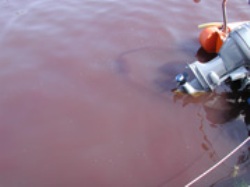The Natural Environmental Research Council (NERC) has awarded a grant of more than £1 million to measure the impact of storms on river pollution. A consortium of scientists belonging to the National Oceanography Centre, and the universities of Southampton, East Anglia and Portsmouth has received the award.

Red tide in Empress Dock
Rivers and estuaries in Britain are being affected by pollutants from drainage, crops and fields. Excess nitrate and phosphate is being found in rivers. This pollution kills fish while increasing the growth of red tides, which are a poisonous algal species. Algae have the detrimental effect of depleting oxygen in water.
The consortium is being led by University of Southampton’s Professor Duncan Purdie, who stated that the study was being done on Christchurch Harbour. The Hampshire Avon and the Stour rivers flow into the enclosed estuary, which has a single narrow connection to the English Channel’s coastal waters. Advanced continuous monitoring techniques will be used to assess the nutrients that enter the estuary during increased inflows due to short-term storms.
Storms stir up sediments in the estuary. The scientists will be studying pollution levels for around a year during which time they will be measuring the pollution levels and nutrient water quality.
The present study is first of a kind. Earlier studies had monitored water quality at specific times. These were not able to capture the data during storm occurrences in estuaries. This project utilizes weather prediction technology and sensors for predicting storms in order to monitor water quality.
Disclaimer: The views expressed here are those of the author expressed in their private capacity and do not necessarily represent the views of AZoM.com Limited T/A AZoNetwork the owner and operator of this website. This disclaimer forms part of the Terms and conditions of use of this website.